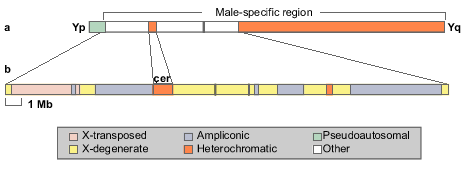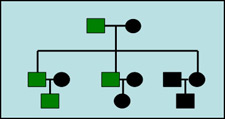Archival Notice
This is an archive page that is no longer being updated. It may contain outdated information and links may no longer function as originally intended.
Home | Glossary | Resources | Help | Contact Us | Course Map
The human Y-chromosome has often been considered an evolutionary relic of the X-chromosome. The Y-chromosome has retained the ability to dictate gender but has little other functional significance. Recent studies have demonstrated that it possesses numerous functional genes, including some that appear to be critical for normal male development.
Approximately 300 million years ago, the X- and Y-chromosomes were true homologues, comparable in size and genetic content.10 Through the passage of time, the Y-chromosome underwent a series of deletion mutations reducing it to its present size of approximately 50 megabases (Mg). This notwithstanding, significant X-chromosome sequence homology still persists.
The chromatin of the Y-chromosome exists in at least three functionally different forms including:
- Pseudoautosomal regions (PARs)
- Euchromatin
- Heterochromatin
The PARs, located in the telomeric regions of the chromosome, pair and recombine with the X-chromosome during male meiosis. The euchromatin (containing the functional genes) and the transcriptionally inert heterochromatin form the non-recombining region (NRY) of the Y-chromosome. Sequencing of the euchromatic region has revealed a patchwork of three distinct sequence classes (see Figure 1).11
The X degenerate sequences are surviving relics from common autosomes from which the X and Y both arose and comprise 39% of contemporary euchromatin. Sequence similarity with the X-chromosome ranges from 60-96%. The X-transposed sequence comprises approximately 15% of the euchromatin sequence and consists of two blocks that are 99% identical to Xq21 sequences. This represents an ancient, massive single X to Y transposition event that occurred 3-4 million years ago after the divergence of the human/chimpanzee lineages. Approximately 46% of the euchromatin contains ampliconic sequences, which occur in seven segments that have as much as 99.9% sequence similarity to other sequences in the euchromatin. Amplicons are characterized by eight palindromic sequences, and the extreme sequence conservation has been attributed to intra-chromosomal gene conversion events. Thus, the Y-chromosome shares significant sequence homology with the X-chromosome, a factor that needs to be considered when designing Y-chromosome specific assays.12
The NRY region of the Y-chromosome is inherited in a patrilineal manner in which a haplotype of physically linked genetic markers is transmitted unchanged, barring the occasional rare mutation, from father to son (see Figure 2).
Reduced genetic variability results from:
- Non-independent segregation of genetic markers on the Y-chromosome
- Enhanced genetic drift potential (due to the smaller effective population size of the Y-chromosome – one-fourth that of autosomes)
Thus, significantly more Y-chromosome markers would be required to provide the same ability to discriminate individuals (the discriminating power) as that obtained by autosomal STR markers. It has even been suggested that this mode of inheritance could enable a particular Y-haplotype recovered at a crime scene to be equated with a surname, although the confounding effects of non-paternity and multiple independent origins of surnames would need to be taken into account.13,14 Notwithstanding the above, it is possible, and in certain circumstances advantageous, to make use of the unique biology of the Y-chromosome for forensic purposes.
Additional Online Courses
- What Every First Responding Officer Should Know About DNA Evidence
- Collecting DNA Evidence at Property Crime Scenes
- DNA – A Prosecutor’s Practice Notebook
- Crime Scene and DNA Basics
- Laboratory Safety Programs
- DNA Amplification
- Population Genetics and Statistics
- Non-STR DNA Markers: SNPs, Y-STRs, LCN and mtDNA
- Firearms Examiner Training
- Forensic DNA Education for Law Enforcement Decisionmakers
- What Every Investigator and Evidence Technician Should Know About DNA Evidence
- Principles of Forensic DNA for Officers of the Court
- Law 101: Legal Guide for the Forensic Expert
- Laboratory Orientation and Testing of Body Fluids and Tissues
- DNA Extraction and Quantitation
- STR Data Analysis and Interpretation
- Communication Skills, Report Writing, and Courtroom Testimony
- Español for Law Enforcement
- Amplified DNA Product Separation for Forensic Analysts



